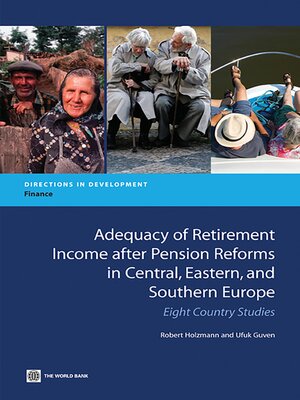Adequacy of Retirement Income after Pension Reforms in Central, Eastern and Southern Europe
ebook ∣ Eight Country Studies · Directions in Development: Finance
By Robert Holzmann

Sign up to save your library
With an OverDrive account, you can save your favorite libraries for at-a-glance information about availability. Find out more about OverDrive accounts.
Find this title in Libby, the library reading app by OverDrive.



Search for a digital library with this title
Title found at these libraries:
| Library Name | Distance |
|---|---|
| Loading... |
All countries in the former transition economies of Central, Eastern, and Southern Europe have undertaken public pension reforms of varying depth and orientation, often with the support of the World Bank. Although the reformed public pension schemes provide broad benefit adequacy, in most cases additional measures are needed to achieve fiscal sustainability in an aging society. 'Adequacy of Retirement Income after Pension Reforms in Central, Eastern, and Southern Europe: Eight Country Studies' assesses the benefit adequacy of the reformed pension systems for eight countries—Bulgaria, the Czech Republic, Croatia, Hungary, Poland, Romania, the Slovak Republic, and Slovenia—to identify policy gaps and options. The authors identify the motivations for reform against the backdrop of the trend toward multi-pillar arrangements, document key provisions, and compare them in the context of the World Bank's five-pillar paradigm for pension reform. They then evaluate the sustainability and adequacy of reformed pension systems and provide recommendations to address gaps and take advantage of opportunities for further reforms. The case studies and summary suggest the following broad policy conclusions: Fiscal sustainability has improved in most study countries, but few are fully prepared for the inevitability of population aging. The linkage between contributions and benefits has been strengthened, and pension system designs are better suited to market conditions Levels of income replacement are generally adequate for all but some categories of workers (including those with intermittent formal sector employment or low lifetime wages), and addressing their needs requires initiatives that go beyond pension policy. Further reforms should focus on extending labor force participation by the elderly to avoid benefit cuts that could undermine adequacy and very high contribution rates that could discourage formal sector employment. More decisive financial market reforms are needed for funded provisions to deliver on the expectations of participants and keep funded pensions safe. This book will be of interest to policy makers, researchers, and everyone interested in the topic of pensions in the region, and beyond.







